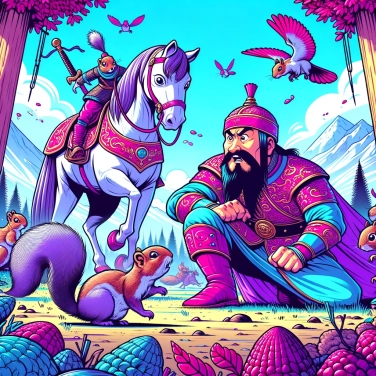Genghis Khan feared squirrels because of their reputation for transmitting the plague. These rodents could carry fleas infected with the bacteria responsible for this disease, making them a threat to the health of his troops.

During the Mongol era, there was a fixed idea: every animal, even the smallest, had a spiritual role. Genghis Khan was immersed in the beliefs of Tengriism, a shamanic religion that attributed certain mystical powers to animals — and squirrels had a bad reputation in the area. These hyperactive little creatures were seen as swift messengers between the spirits of the sky and the earth, capable of bringing visions or omens. For Genghis Khan, a squirrel seen at the wrong time could clearly herald a military defeat, a betrayal, or worse. Some Mongolian shamans even interpreted the piercing gaze of these creatures as a bad omen, capable of bringing misfortune to an entire army. It is not surprising, then, that the great conqueror always kept a wary eye on these little balls of fur.
Among the Mongols, the squirrel often embodied an agile messenger capable of linking the world of humans to that of spirits. Considered lively, elusive, and impossible to fully catch, squirrels also represented chaos and unpredictability. Some legends say that encountering a squirrel heralded an unforeseen event, not always a good one, in fact. This animal was even associated with mischievous spirits that disturbed tranquility or brought bad luck. In short, far from being just a friendly mascot, these little creatures were seen as symbols that should never be underestimated.
In history, squirrels have often been suspected of transmitting diseases, sometimes serious ones. For example, in Mongolia and Central Asia, these small animals can carry plague, a severe illness transmitted by fleas infesting their fur. At the time of Genghis Khan, even a minor outbreak could decimate an entire army in a matter of weeks. Add to that their annoying habit of gnawing on absolutely everything that comes their way: provisions, saddles, quivers... enough to seriously sabotage essential military equipment. This destructive reputation and their potential role in disease transmission may have been more than sufficient to justify Genghis Khan's genuine distrust of these seemingly harmless animals.
There are a few anecdotal stories in Mongolian history that recall embarrassing moments when Genghis Khan openly expressed his annoyance at squirrels. Notably, during a famous hunting trip around 1206, he reportedly suddenly turned his horse after spotting a group of squirrels crossing his path, which even caused one of his companions to fall. Another anecdote, reported by contemporary witnesses, tells how an imperial tent was completely ravaged during a military campaign because squirrels had gnawed the ropes, forcing the famous Mongolian warrior to sleep outside, amid the discreet laughter of his entourage. These minor but well-documented events illustrate a rather tense relationship between the powerful Mongolian leader and these mischievous little rodents.
Genghis Khan's strange fear of squirrels had surprising consequences on his military decisions. For example, when moving his troops, he carefully avoided dense forests, known for their high squirrel population, favoring open steppes despite the increased risk of being spotted. Similarly, he regularly strengthened the security of his camps by installing more sentinels near wooded areas to detect any suspicious presence of squirrels. When scouts reported a high activity of these rodents, he did not hesitate to completely change his route, even if it meant wasting time or significantly lengthening his journeys. This unusual habit even influenced his decisions regarding the choice of battle sites, systematically favoring open plains, far from squirrels, rather than strategically advantageous but wooded locations.
According to some legends, Genghis Khan would regularly consult shamans before major events in his military life—appearances of squirrels were often noted as bad omens by these spiritual advisors.
Some ancient Mongolian texts stated that encountering a squirrel during a battle signified an impending defeat, which led Mongolian generals to change their routes or strategies on the battlefield.
The Mongolian term for squirrel, 'ziraa', also carries a connotation related to agility and unpredictability, which explains why these small mammals garnered so much attention and superstition in Mongolian culture.
The Mongols had developed complex traps to protect their provisions from squirrels, as these animals could cause significant losses to their food supplies, which were essential during long military campaigns.
There are no direct traces formally proving a specific influence on his military decisions related to squirrels. However, caution regarding diseases carried by small animals or a personal superstition may have indirectly influenced his strategic choices, particularly in the selection of locations for his camps or battles.
Among the Mongols of that time, several animals held strong symbolic meaning. The wolf was particularly revered as a symbol of courage, strength, and unity, while the horse remained essential as a faithful companion and means of conquest. The squirrel, on the other hand, is mentioned less frequently and could have symbolized, according to some oral traditions, bad luck or cunning deceit.
Yes, some small mammals, such as squirrels, could potentially transmit diseases like the bubonic plague through parasites, such as the rat flea. Although their precise involvement in the epidemics of the time remains unclear, the fear of disease transmission could have influenced perceptions of these animals throughout history.
Absolutely. In medieval Europe, as well as in certain Asian traditions, squirrels were often viewed in a complex light: sometimes seen as creatures symbolizing caution and wisdom, while at other times perceived as harmful or malevolent due to their ability to steal and hide provisions, thus symbolizing the stealthy diversion of wealth.
Although there is no conclusive evidence of such fear in official historical sources, several popular traditions and oral narratives from Mongolia mysteriously reference their distrust of these animals. It is therefore important to consider these accounts with caution, distinguishing popular anecdotes from historical reality.

No one has answered this quiz yet, be the first!' :-)
Question 1/5